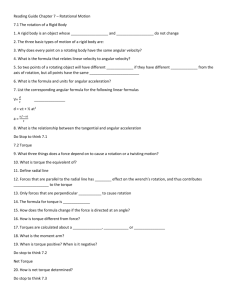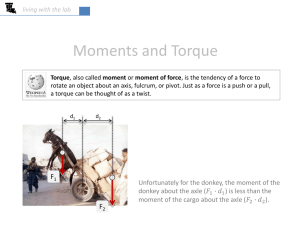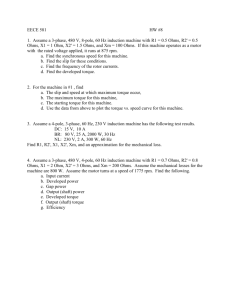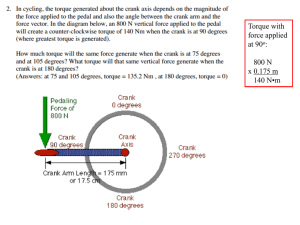Introduction
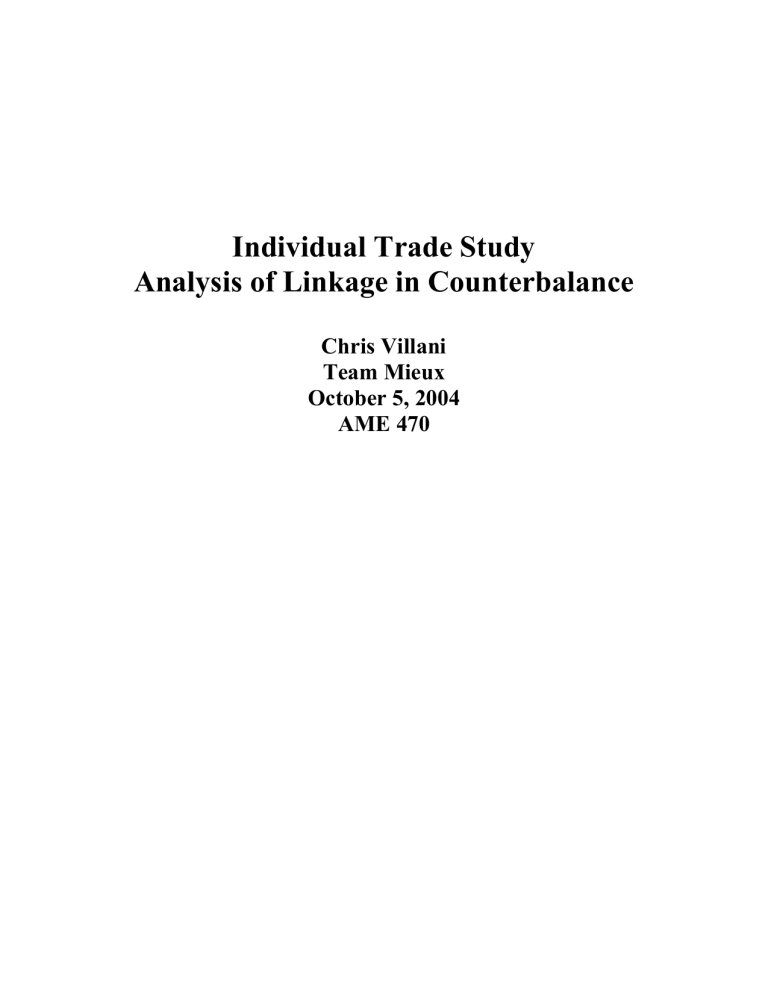
Individual Trade Study
Analysis of Linkage in Counterbalance
Chris Villani
Team Mieux
October 5, 2004
AME 470
Introduction
The purpose of this document is to study the feasibility of rotating the counterbalance weight with a four-bar crank rocker linkage or in an inline crank slider arrangement. The study will assess which design is more suitable for this application and then determine the correct size for a motor.
Variables and Constraints
The analysis of this subsystem requires that certain design variables be chosen and their effect on the entire subsystem be analyzed. The design variables to be optimized in this study are:
The lengths of the linkages
The geometric arrangement of the linkage
The DC motor used to drive the linkage
These design variables will prescribe the following state variables
The torque applied by the motor, T.
The time to complete one entire cycle.
The weight of the linkage.
The voltage necessary to power the linkage.
The speed of rotation of the counterbalance.
The variables are subject to the following constraints
The limit positions of the output, the device must go to an angle of 16° in the rear and 54° in the front.
Geometric constraints set by chassis design and ASME specifications.
Geometric constraints of the chassis (2.945” X 7”)
Support the load due to the counterbalance weight and length (length=7.5” Mass=2.8lb)
Availability of motors
Cost.
Measure of Merit
Linkage Design
The determination of the use of a four-bar system or a crank-slider system will be based upon two criteria, allowable range of motion and torque requirements. The following criterion must be met or else the design is deemed unacceptable.
1)
The rotation of the linkage must allow the counterbalance to have at least 110° of rotation
2) The linkage torque requirements must be no more that 12in-lb.
Motor Requirements
The motors will be selected primarily upon the basis of torque. From the analysis of the linkage design a design torque will be determined. A factor of safety of 1.5 will be applied to this and this will be the torque for which is designed
The motor will also be assessed on the following characteristics
Voltage
Speed
Current
Power
The between any two components the percent difference in each characteristic will be determined. The chosen component will be that with the higher sum of favorable percent differences.
Methods
The geometry of the linkage is dictated by the need to have limit positions where the counterbalance is needed to raise the vehicle. In this way there is no need to have a torque applied by the motor due to the high mechanical advantage. In the case of a four bar linkage this will occur when the output and coupler become aligned. In the case of a crank-slider, the limits occur when the transmission angle is 90° (when the slider is at a 90° angle to the input).
To analyze the four-bar was performed using a Newton’s Method and a force analysis of a four bar system. Newton’s method was utilized to determine the unknown variables θ
3
and θ
4
. With these known variables known, a static force analysis was performed to determine the torque requirements of the motor on the input.
A force analysis was also utilized to determine the torques needed on the crank slider. The input was rotated from the rear to the front and the necessary torques.
Newton’s Method & Force Analysis of Four Bar Linkage
Newton’s method is a numerical iteration used to attain unknowns. It involves the correction of error functions in order to converge at the values for the unknowns θ
3
and θ
4
In the case of a four-bar linkage the error functions are:
It is desirous that as :
such that in there will be convergence. Δε
I
may be approximated
Using these relationships values of Δθ
3
and Δθ
4
can be determined to find the next value. This iterative process will continue until the error is with the limit of 0.001° This process is repeated for the values of θ
2 ranging from 0° to 360°.
Given all of the variables in the system it is now possible to perform a force analysis using
Newton’s Laws to determine the minimum applied torque.
For this analysis it will be assumed that the weights of the links are frictionless given that the mass of the counterbalance is significantly large. The force of the counterbalance on the linkage due to the counterbalance can be given by where θ g
is the reference angle to the gravity field and W c
is the scalar weight of the counterbalance. Since link three is a two force member, the forces acting along it must be in the direction of θ
3 with the magnitude of this force being F . Therefore the forces on the pin joining link three to link two has the same magnitude and opposite direction. The same is true at the pin joining link three to body four. A force of equal magnitude and direction is applied at the grounded pin in links two and four.
Taking the moments about B o yields the following equation:
From this equation the magnitude of F can be determined. Taking the moments about A o yields: or
(A Free Body Diagram of this system can be found in the Appendix.)
Analysis of Crank Slider
As was for the four bar analysis, the weights of the links are assumed to be negligible. The moments taken about the output pin joint can be described as:
With this equation the magnitude of F can be found. It is known that F acts at a perpendicular to the output since it is connected with a pin joint.
Taking the moments about the input joint yields the following equation.
From this the value of the torque needed can be determined. ( A Free Body Diagram of the system may be found in the appendix.)
Results
Figure 1 is an output of the required torque for a given length of the crank. The plot shows that the crank size increases so does the requirement of the torque. The torque goes beyond of the range of motor torques available after the length reaches 1in.
Figure 1 – Four-bar crank length vs torque plot. Figure 2- Crank Slider Torque requirements.
Figure 2 shows the relationship between the crank slider position and the required torque. In this case however the length of the crank does not affect the torque because the slider only produces a force perpendicular to the output. The maximum torque required in this mechanism is 12in-lb at approximately 55° from the horizontal.
Rotational Limits
The four bar system greatly impedes the range of motion of the counterbalance. Because of the strict size limit imposed by the torque availability in available motors, it has been determined by a graphical method that a four-bar system has approximately a 20° range of motion. This is unacceptable for this application where a minimum of 110° is needed.
The crank-slider arrangements allows for 110° of motion. This accomplishes the need for the counterbalance to rotate from 16° from the horizontal in the rear to 54° from the horizontal in the front.
Conclusions on Linkage Designs
From the above data it has been shown that the four bar linkage in unacceptable for this design.
It fails both criterions for use in this application. With only a 20° range of motion it will be unable to raise the vehicle into the raised position. The high torque requirements are beyond the capacity of a single motor. It is impossible to make a four-bar device function in this application due to the constraints of size and power.
The crank-slider design passes both requirements. The range of rotation allows the vehicle to place its center of mass beyond the rear wheels and on top of the front wheels. This is essential to assist in the stair climbing/ascending process. The torque requirements for this system are also within the tolerances set forth. For these reasons, this will be the design considered from here forth. The design torque will hence be 18in-lb (288in –oz). The crank will be made to be
3.25in. This is half the length of the output arm. This will alleviate the problems of having small parts with high stresses and will allow for easy manufacturing. The size of this part does not have nay affect on the system’s torque need.
Motor Analysis
The following motors have been selected for review and are documented in the table below. The values of the current, speed, efficiency, power and voltage for the design torque are listed in the table below.
Igarashi Motors
Motor 1 Motor 2
Igarshi 376N2738-275-G-3
0.2A (50%)
1RPM
0.2W (50%)
15% Efficiency
6V
Igarshi 33G3020-150-G-3
0.4A
2.8RPM (180%)
0.4W
25% Efficiency
4V (50%)
Total Percent Difference= 100% Total Percent Difference = 230%
The Igarch i33G3020-150-G-3 is the motor with the larger percent difference and therefore will be the component of choice. Although it has a higher amperage and power than the other motor, it is nearly two times as fast. In a design where speed is essential for success, this is a crucial variable. The power constraint also is an important indicator. Since the power is large the vehicle must conserve as much of its power as possible. This means having an efficient and fast route.
Influence of Results
These results will help to clarify other design issues by adding limits to the weight. This study has given specific dimensional requirements for the counterbalance. With this study in place there is now a limit on home much the vehicle can weigh such that it can still raise to the upright position.
The study also has begun to limit the power available for other components. When the vehicle needs to be raised 0.4W of power will need to be delegated to the counterbalance motor. This large implies that the other four driving motors must be turned off.
Final Summary
The counterbalance will be controlled by a 2.66in crank sliding along a 7.5in output connected to the counterbalance. The pin joints will be offset by 19° from the vertical such that the desired
16° counterbalance limit is achieved. The crank will rotate 270° degrees such that the output rotates 110° to the 54° from the horizontal position in the front of the vehicle. The use of a fourbar system has been eliminated. The system requires 12in-lbs of torque to operate. The motor has been chosen such that it can provide 18in-lb of torque (a safety factor of 1.5) it requires
0.4Watts of power by 0.4A.




